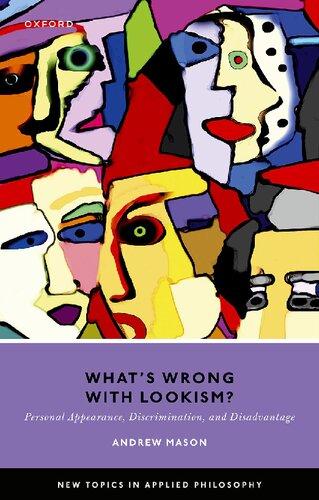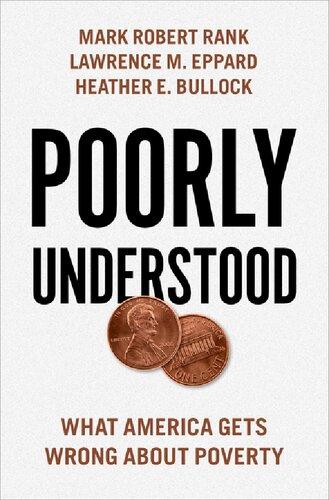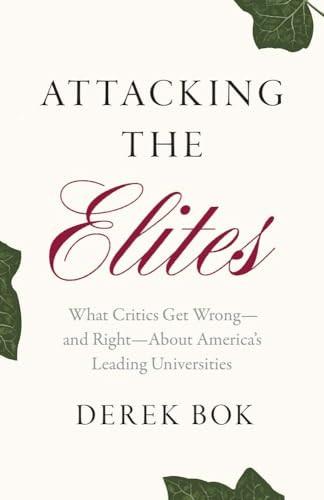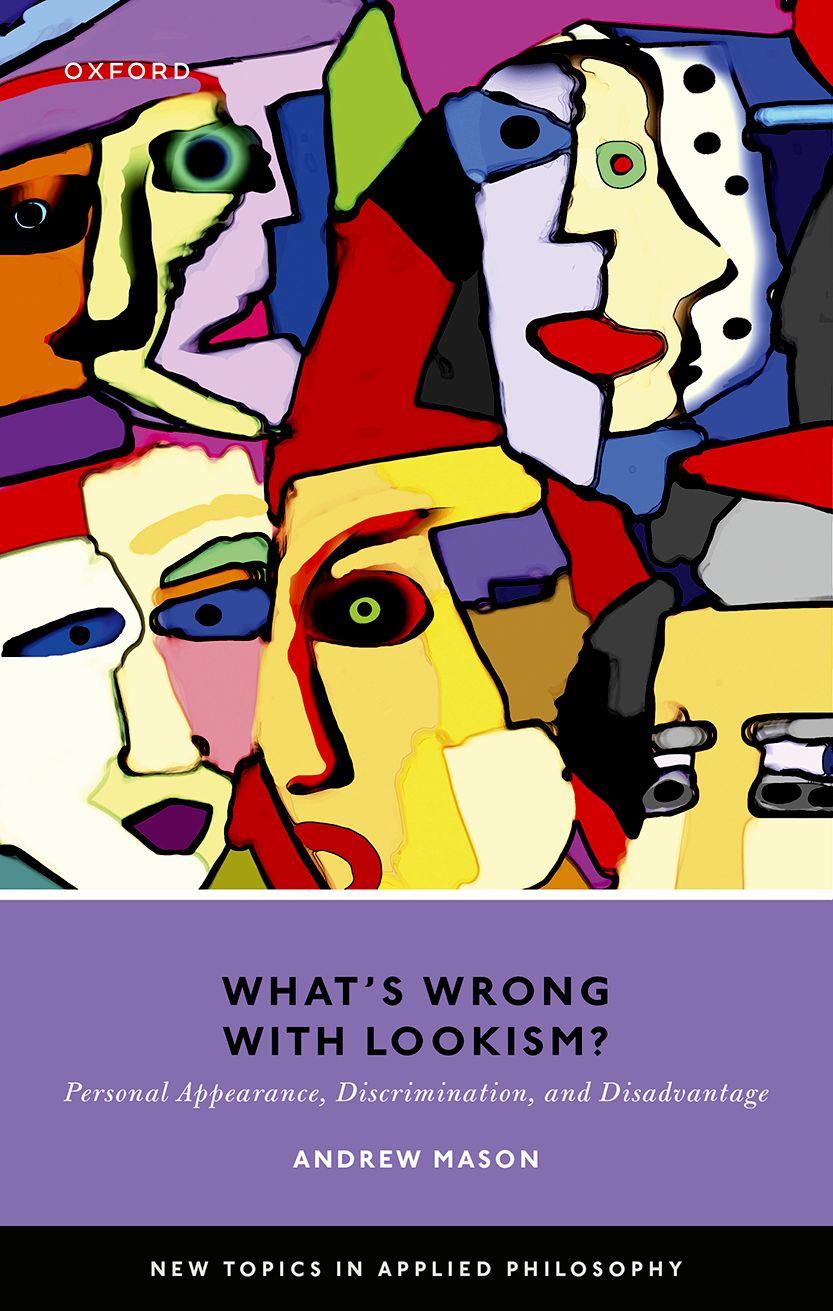What’s Wrong with Lookism?
Personal Appearance, Discrimination, and Disadvantage
ANDREW MASON
Great Clarendon Street, Oxford, OX2 6DP, United Kingdom
Oxford University Press is a department of the University of Oxford. It furthers the University’s objective of excellence in research, scholarship, and education by publishing worldwide. Oxford is a registered trade mark of Oxford University Press in the UK and in certain other countries © Andrew Mason 2023
The moral rights of the author have been asserted
All rights reserved. No part of this publication may be reproduced, stored in a retrieval system, or transmitted, in any form or by any means, without the prior permission in writing of Oxford University Press, or as expressly permitted by law, by licence or under terms agreed with the appropriate reprographics rights organization. Enquiries concerning reproduction outside the scope of the above should be sent to the Rights Department, Oxford University Press, at the address above
You must not circulate this work in any other form and you must impose this same condition on any acquirer
Published in the United States of America by Oxford University Press 198 Madison Avenue, New York, NY 10016, United States of America
British Library Cataloguing in Publication Data Data available
Library of Congress Control Number: 2023935137
ISBN 978–0–19–285979–2
DOI: 10.1093/oso/9780192859792.001.0001
Printed and bound by CPI Group (UK) Ltd, Croydon, CR0 4YY
Links to third party websites are provided by Oxford in good faith and for information only. Oxford disclaims any responsibility for the materials contained in any third party website referenced in this work.
Acknowledgements
I first became interested in the issue of appearance discrimination about fifteen years ago, partly as a result of a conversation with a colleague whilst I was working at the University of Southampton. Her partner was a tree surgeon. He was offered employment by a company in the New Forest on condition that he cut off his dreadlocks, which he wasn’t willing to do. The requirement that he do so before taking up the job, which was imposed on grounds of appearance rather than any concerns about health and safety, struck me as unfair and got me thinking about the morally problematic character of many of the ways in which appearance discrimination impacts upon our lives, and how it intersects with other forms of discrimination.
This book is the culmination of these reflections. It has benefitted considerably from the help given to me by a number of people. I am immensely grateful to Matthew Clayton, Søren Flinch Midtgaard, Francesca Minerva, Tom Parr, and two anonymous referees for OUP, each of whom gave me detailed written comments on an early draft. Matthew, Francesca, and Tom, together with Catalina Carpan, Ida Lübben, and Nici Mulkeen, were also members of a reading group which discussed that draft in virtual meetings during the pandemic. In a kind and generous way, they helped me to see a range of problems with my arguments in it. The book would have been much worse without their input.
Søren organized a workshop on a second draft of the manuscript, at the Centre for the Experimental-Philosophical Study of Discrimination (CEPDISC) at Aarhus University in October 2021. This was my first trip away after the pandemic. Not only was it very enjoyable to be part of an in-person event again, I also learnt a lot from the criticisms and suggestions offered by the participants, especially Simone Sommer Degn, Renaud-Philippe Garner, Nils Holtug, Kasper Lippert-Rasmussen, Lauritz Munch, Astrid Fly Oredsson, Viki Møller Lyngby Pedersen, and Søren himself, who commented on individual chapters. I returned to CEPDISC for a month in May 2022 whilst writing the final draft. I am grateful to Søren again, and to Kasper, for facilitating my stay in such a friendly and stimulating environment.
There are also a number of friends, colleagues, family members, and acquaintances who have given me feedback on individual chapters or papers
on which those chapters are based, or have provided me with help when I sought it. I would like to express my warmest thanks to the following people: Chris Armstrong, Rima Basu, Richard Bellamy, Rossella De Bernardi, Paul Billingham, Kim Brownlee, Cheshire Calhoun, Simon Caney, Clare Chambers, Raf Geenens, Bob Goodin, Deborah Hellman, Eszter Kollar, Lauren Lyons, Matt Mason, Sam Mason, Véronique Munoz-Dardé, Merten Reglitz, Becca Rothfeld, Ben Sachs, Mike Saward, Gina Schouten, Helder De Schutter, Shlomi Segall, Rob Simpson, Adam Slavny, Tom Sorell, Hillel Steiner, Adam Swift, Lynn Thomas, Annamari Vitikainen, Bouke de Vries, Albert Weale, Katy Wells, and Heather Widdows.
Individual chapters, or the papers or ideas on which they are based, were presented at a number of workshops and seminars. Some of the central ideas of the book were aired at the Legal and Political Theory Working Group seminar series at the European University Institute, and later at the Philosophy Department seminar at the University of Otago. I also enjoyed extended stays at both places, the former courtesy of a Fernand Braudel Fellowship. I am grateful to Rainer Bauböck and Richard Bellamy for taking care of me at the EUI, and Andrew Moore for facilitating my stay at Otago. I would also especially like to thank Lisa Ellis, Michael LeBuffe, James Maclaurin, and David Tombs for their support whilst I was in Dunedin.
My paper ‘Appearance, Discrimination, and Reaction Qualifications’, which was published in the Journal of Political Philosophy and in a somewhat revised form provides the basis of Chapter 5, was presented at different stages of development at various workshops and colloquia. I would like to thank participants in these at Goethe University Frankfurt, the University of Manchester, Nuffield College, Oxford, and the University of Warwick for their constructive criticisms. The final version of the paper was written whilst I was a visiting fellow at the Justitia Amplificata Centre for Advanced Studies at Goethe University. I would like to thank Rainer Forst for inviting me to spend time at the Centre, and the fellows and staff at the Forschungskolleg Humanwissenschaften for making my period of residence there so enjoyable and productive.
The paper ‘What’s Wrong with Everyday Lookism?’, which forms the basis of Chapter 7, and which was published by Politics, Philosophy and Economics, was presented under a different title at a number of places: the summer school on ‘The Morality of Discrimination’ held at the Central European University in Budapest; the CEPPA seminar at the University of St Andrews; the Law, Politics, and Philosophy Colloquium at University College London; and the RIPPLE seminar at KU Leuven. My spell as a
visiting fellow at RIPPLE was cut short by the emerging pandemic and the lockdown introduced to combat it, but I am very grateful to the members of that research group, especially Eszter Kollar and Helder De Schutter, for making me so welcome.
I would not have been able to complete the book were it not for a Leverhulme Research Project Grant (RPG-2018-316). I would like to thank the Trust for this award, and Roger Crisp and Sue Mendus for the encouragement and support they gave to me in relation to my research plans. Francesca Minerva was also part of this Leverhulme funded project, providing me with much valued research assistance during the early stages of it. I would like to thank her for permission to re-use (in Chapter 8) material from our co-authored article, ‘Should the Equality Act 2010 Be Extended to Prohibit Appearance Discrimination?’, which was published in Political Studies. When Francesca moved to the University of Milan, Rossella De Bernardi took over her role and offered a fresh perspective on some of the issues I have discussed in the book. Joost Pietschmann also provided additional research assistance in the first year of the project. Finally, I am grateful to Peter Momtchiloff, the editor in charge of the book at OUP, and Tara Werger, the title manager, for guiding it so expertly through the publication process.
1 Introduction
You never just get called a bitch, it’s always ‘fat bitch’. . . . When it comes to being plus-size, it’s always that descriptor that’s thrown in there to remind you of who you are, what’s your place, and why you’re not equal. And that sucks.1
My old boss was against body modifications because of her religious beliefs. I was constantly harassed about my piercings and tattoos. I had hours cut after getting my tattoos, even though they aren’t visible. I have both feet done as well, but always wear socks and shoes. I work in childcare and was told that even out in public I had to keep appearances up, so to keep covered, because I might see the children I looked after outside hours.2
I am West African, and I work at a consultancy firm in London. I am always being made to feel that my natural hair gives the impression that I am unprofessional . . . . A few years ago I had my hair styled in cornrows and I was asked quite blatantly by my boss how long it would be before my hair was back to ‘normal’. I was taken aback. I could not believe what I was hearing. Although shocked, I did change my hairstyle—I did not want my hair to be the cause of problems for me at work.3
The reality is, as a short man you can expect eight out of 10 women to immediately dismiss you as a potential sexual partner at first sight. The chances are, the remaining two out of 10 will only give you a couple of minutes to make your case before making excuses.4
1 From The Guardian, at https://www.theguardian.com/lifeandstyle/2019/may/12/insultsprojectiles-well-intentioned-fat-shaming-the-perils-of-being-a-plus-size-runner. Accessed 2 July 2022.
2 From BBC News, at https://www.bbc.co.uk/news/magazine-29211526. Accessed 2 July 2022.
3 From BBC News, at https://www.bbc.co.uk/news/uk-36279845. Accessed 2 July 2022.
4 From BBC News, at https://www.bbc.co.uk/news/stories-49567527. Accessed 2 July 2022.
What’s Wrong with Lookism? Personal Appearance, Discrimination, and Disadvantage. Andrew Mason, Oxford University Press. © Andrew Mason 2023. DOI: 10.1093/oso/9780192859792.003.0001
Living with a facial disfigurement, in a busy city like London, means I am rarely invisible. Even something as simple as a train journey can turn into a gauntlet of stares, pointing and whispers.5
People are treated differently as a result of their appearance. Those regarded as overweight are regularly disadvantaged by their body shape or size when they apply for jobs; it is often harder for them to find romantic partners; and they are vulnerable to harassment and bullying in various settings, such as at school or on social media.6 The treatment they receive may be rooted in appearance norms that apply demanding aesthetic standards to body shape and size, or have its origins in prejudices that express moral criticism by associating higher weight with a lack of self-discipline. People with prominent tattoos are often treated less favourably in employment decisions and in their everyday encounters as a result of conventional attitudes that are sometimes laced with moral judgements concerning the sanctity of the natural body, or influenced by prejudices that link extensive tattoos with aggression or mental health problems. Afro-textured hairstyles are frequently regarded as unsuitable for the workplace, motivating restrictive appearance codes that disproportionately affect members of racial groups whose hair is naturally suited to being worn in these ways. Short men are commonly regarded as less attractive; they are disadvantaged not only when it comes to dating but also in terms of their career prospects. They are treated less favourably not merely because they are found lacking when judged against appearance norms concerning ideal height, but also because they are the victims of prejudices linking shortness in height to inferiority complexes that supposedly make them over-sensitive and prone to aggression. Those with facial differences, sometimes as a result of physical disabilities, may experience greater difficulty in obtaining employment and finding romantic partners, and they may suffer unwanted attention or bullying in various contexts.
Considerable importance is attached to our appearance—too much, we might reasonably think. But when does lookism, by which I mean treating
5 From BBC News, at https://www.bbc.co.uk/news/blogs-ouch-33623011. Accessed 2 July 2022.
6 I use the expressions ‘people regarded as overweight’ and ‘people with a heavier weight’ to pick out victims of ‘fat-shaming’. Although the term ‘fat’ is in the process of being reclaimed by the fat acceptance movement, it still carries negative connotations. See A. Meadows and D. Sigrún, ‘What’s in a Word? On Weight Stigma and Terminology’, Frontiers in Psychology 7 (2016), https://doi.org/10.3389/fpsyg.2016.01527.
someone differently on the basis of their appearance in a way that either advantages or disadvantages them, constitute wrongful discrimination?7 This issue matters for at least two reasons that are foreshadowed in the examples with which I began.
First, the advantages experienced as a result of being regarded as attractive are considerable and are enjoyed in a wide variety of contexts.8 Consider some of the evidence. According to Daniel Hamermesh’s analysis of data from the US, below average-looking women earn 4% less than averagelooking women, whereas above average-looking women earn 8% more than those who are average-looking; below average-looking men earn 13% less than average-looking men, whereas above average-looking men earn 4% more than average-looking men. In other words, the overall ‘beauty premium’ for good-looking women is 12%, whereas for men it is 17%.9 Extensive research on the impact of appearance on success in elections for political office suggests that voters are strongly influenced by the attractiveness of candidates (and also by whether they think they look competent, which correlates to some extent with perceiving them as attractive). This is so especially in the case of male candidates, and especially when voters are less familiar with the candidates’ policy preferences, their track records, and the party for which they are standing.10 In schools, facial attractiveness
7 In framing the question in this way, I am adopting a non-moralized account of both lookism and discrimination, that is, an account which does not automatically imply that either lookism or discrimination is wrongful. For further elucidation of the notion of discrimination I am employing, see Section 2.1.
8 When I refer to unattractiveness or attractiveness in this book, I mean the possession of an attractive or unattractive appearance.
9 See D. S. Hamermesh, Beauty Pays: Why Attractive People Are More Successful (Princeton, NJ: Princeton University Press, 2011), 45–6. It is worth noting, however, that the evidence that Hamermesh cites concerns facial beauty in particular and much of it is collected on the basis of inter-subjective ratings of photographs of faces, either on a scale of 0–5 or on a scale of 0–10. This raises questions about what features and qualities influence our judgements about a person’s visual attractiveness. As Hamermesh acknowledges, overall judgements about it may be based on other features of their appearance, such as their shape and height.
10 See M. Efran and E. W. J. Patterson, ‘Voters Vote Beautiful: The Effect of Physical Appearance on a National Election’, Canadian Journal of Behavioural Science/Revue Canadienne des Sciences du Comportement 6 (1974): 352–6; A. King and A. Leigh, ‘Beautiful Politicians’, Kyklos 62 (2009): 579–93; N. Berggren, H. Jordahl, and P. Poutvaara, ‘The Looks of a Winner: Beauty and Electoral Success’, Journal of Public Economics 94 (2010): 8–15; S. Banducci, J. Karp, M. Thrasher, and C. Rallings, ‘Ballot Photographs as Cues in Low-Information Elections’, Political Psychology 29 (2008): 903–17; A. Todorov, A. Mandisodza, A. Goren, and C. Hall, ‘Inferences of Competence from Faces Predict Election Outcomes’, Science 308 (2005): 1623–6; D. Stockemer and R. Praino, ‘Blinded by Beauty? Physical Attractiveness and Candidate Selection in the U.S. House of Representatives’, Social Science Quarterly 96 (2015): 430–43; R. Praino, D. Stockemer, and J. Ratis, ‘Looking Good or Looking Competent? Physical Appearance and Electoral Success in the 2008 Congressional Elections’, American Politics
influences the expectations of teachers, and their assessment of their students, with respect to both academic performance and social skills.11 In the sphere of personal relationships, appearance matters a lot when people are choosing potential romantic partners, although there is some evidence to suggest that it matters more to men than to women, and that it matters less to both sexes when relationships have become established.12 With respect to crime, people regarded as unattractive are more likely to be convicted of an offence than those regarded as attractive, and when convicted they are more likely to receive harsher punishments.13 Going beyond the scope of this book, appearance discrimination is not limited in its impact to human beings: people are often more willing to donate to wildlife conservation projects that benefit species that are charismatic partly in virtue of their visual appeal, and organizations as a result tend to use these species as flagships in their marketing campaigns.14
Research 42 (2014): 1096–117; W. Hart, V. Ottati, and N. Krumdick, ‘Physical Attractiveness and Candidate Evaluation: A Model of Correction’, Political Psychology 32 (2011): 181–203.
11 Some studies suggest that this influence weakens over time as teachers get to know their students better, and others that it is not only the expectations of teachers that influence the performance of attractive students but also the expectations of their parents. See J. Dusek and G. Joseph, ‘The Bases of Teacher Expectancies: A Meta-Analysis’, Journal of Educational Psychology 75 (1983): 327–46; V. Ritts, M. Patterson, and M. Tubbs, ‘Expectations, Impressions, and Judgments of Physically Attractive Students: A Review’, Review of Educational Research 62 (1992): 413–26; J. Langlois, L. Kalakanis, A. Rubenstein, A. Larson, M. Hallam, and M. Smoot, ‘Maxims or Myths of Beauty? A Meta-Analytic and Theoretical Review’, Psychological Bulletin 126 (2000): 390–423.
12 A. Feingold, ‘Matching for Attractiveness in Romantic Partners and Same-Sex Friends: A Meta-Analysis and Theoretical Critique’, Psychological Bulletin 104 (1988): 226–35; J. Sangrador and C. Yela, ‘ “What Is Beautiful Is Loved”: Physical Attractiveness in Loving Relationships’, Social Behavior and Personality: An International Journal 28 (2000): 207–18; S. Sprecher, Q. Sullivan, and E. Hatfield, ‘Mate Selection Preferences: Gender Differences Examined in a National Sample’, Journal of Personality and Social Psychology 66 (1994): 1074–80; L. Lee, G. Loewenstein, D. Ariely, J. Hong, and J. Young, ‘If I’m Not Hot, Are You Hot or Not? Physical-Attractiveness Evaluations and Dating Preferences as a Function of One’s Own Attractiveness’, Psychological Science 19 (2008): 669–77; P. Eastwick, L. Luchies, E. Finkel, and L. Hunt, ‘The Predictive Validity of Ideal Partner Preferences: A Review and Meta-Analysis’, Psychological Bulletin 140 (2014): 623–65.
13 N. Mocan and E. Tekin, ‘Ugly Criminals’, Review of Economics and Statistics 92 (2010): 15–30; B. W. Darby and D. Jeffers, ‘The Effects of Defendant and Juror Attractiveness on Simulated Courtroom Trial Decisions’, Social Behavior and Personality 16 (1988): 39–50; J. Stewart, ‘Appearance and Punishment: The Attraction-Leniency Effect in the Courtroom’, Journal of Social Psychology 125 (1985): 373–8; J. Stewart, ‘Defendant’s Attractiveness as a Factor in the Outcome of Criminal Trials: An Observational Study’, Journal of Applied Social Psychology 10 (1980): 348–61.
14 B. Clucas, K. McHugh, and T. Caro, ‘Flagship Species on Covers of US Conservation and Nature Magazines’, Biodiversity and Conservation 17 (2008): 1517–28; R. Smith, D. Verıssimo, N. Isaac, K. Jones, ‘Identifying Cinderella Species: Uncovering Mammals with Conservation Flagship Appeal’, Conservation Letters 5 (2012): 205–12; J. Lorimer, ‘Nonhuman Charisma’, Environment and Planning D: Society and Space 25 (2007): 911–35
Second, appearance discrimination is of moral interest not only in its own right but also in terms of its connection to other forms of discrimination. Appearance norms, that is, norms concerning how we should look, often place greater burdens on disadvantaged groups. Some of these norms are harder for Black or mixed-race people to comply with, such as norms that favour straight hair over tight curls; some adversely affect people with particular disabilities, such as norms that value symmetrical bodies; some are gender-specific, such as norms governing breast size and shape, or more demanding for women than they are for men, such as norms governing body shape and size; some are more demanding for older people, such as norms that prize firm, wrinkle-free, unblemished skin; and norms governing how we should dress are often more burdensome for the economically deprived because the clothes required to comply with them are expensive. As a result, discrimination on the basis of appearance, when it rewards people who conform to these norms, may involve, or interact with the effects of, wrongful discrimination on the basis of features other than appearance, in a way that aggravates existing injustices.15
Here, for clarity, we need to distinguish between direct and indirect discrimination. According to the notion that I shall be employing, A discriminates against P directly if and only if A treats P less favourably than Q because P has some property C that Q lacks (or A mistakenly believes P has that property). A man who endorses and complies with an appearance norm that adversely affects members of a disadvantaged group need not be engaged in direct discrimination against them. But even when he is not directly discriminating against them, he is indirectly discriminating against them in so far as the norm with which he is complying on average adversely affects members of that group more than it does members of other groups. Understood in these ways, however, there is no automatic valid inference from the occurrence of either direct or indirect discrimination to the conclusion that it is wrongful. Before exploring what makes appearance discrimination of either kind wrongful, we would benefit from a clearer picture of what appearance discrimination is, how we identify it, and how and why it occurs.
15 This is an illustration of the broader phenomenon of ‘intersectionality’, a term coined by Kimberlé Crenshaw: see K. Crenshaw, ‘Demarginalizing the Intersection of Race and Sex: A Black Feminist Critique of Antidiscrimination Doctrine, Feminist Theory and Antiracist Politics’, University of Chicago Legal Forum 1 (1989): 139–67. For a helpful overview of the origins of the concept, and the way it has been deployed, see A. Carastathis, ‘The Concept of Intersectionality in Feminist Theory’, Philosophy Compass 9 (2014): 304–14.
1.1 What Is Appearance Discrimination, How Do We Identify It, and How and Why Does It Occur?
By a person’s appearance, I mean the way (or ways) in which the attributes of his or her body, and how it is adorned or modified, are (or would be) perceived visually under standard conditions by those who possess normal visual capacities together with any relevant cultural knowledge. Possession of relevant cultural knowledge may be necessary in order to perceive visually some bodily features, modifications, or adornments in a way that involves an appreciation of their social significance. At one level of description, a tattoo is merely an ink marking on a person’s skin but understanding its meaning may involve specific cultural knowledge.
There is a degree of arbitrariness in defining appearance in this way. I am, in effect, equating appearance with visual appearance, and excluding from the realm of appearance other attributes we possess that impinge upon the senses of others, for example, our accents, the register of our voices, and the way we smell. Giving ‘appearance’ this restricted meaning has some warrant in ordinary usage, but I would not want to deny that many of the same questions that I am raising about discrimination on the basis of (visual) appearance could also be raised about discrimination on the basis of these other attributes.
A person’s appearance includes attributes that they are born with (for example, a cleft lip), attributes that they have because of what has happened to them (for example, scarring that occurs a result of an accident), and attributes that are wholly or partly a product of their choices (for example, clothing, tattoos, piercings, and hairstyles), including features that are a result of habitual behaviour that they could change (for example, whether they shave parts of their body). Appearance is therefore a broad category. For some purposes, nothing is lost by lumping together these diverse attributes. For other purposes, we may want to separate out particular attributes, or groups of attributes, and consider them separately. For example, as a result of bullying and body shaming, those who are regarded as overweight may constitute a socially salient group, that is, a group the perceived membership of which is ‘important to the structure of social interactions across a wide range of social contexts’.16 Whether people judged to be attractive, or deemed to be unattractive or ugly, constitute socially salient groups is
16 K. Lippert-Rasmussen, Born Free and Equal? A Philosophical Inquiry into the Nature of Discrimination (Oxford: Oxford University Press, 2014), 30.
harder to determine given that attractiveness and unattractiveness take many different forms.
Not all discrimination on the basis of physical attributes constitutes direct discrimination on the basis of appearance. A person’s weight is a physical attribute, but if those who weigh more than a hundred kilogrammes are rejected for a job solely because it involves walking on delicate roof structures that would be unable to withstand heavier weights, then they are not being directly discriminated against on the basis of their appearance. Weight discrimination counts as a form of direct appearance discrimination only when those engaged in it are ultimately responding to their visual perception of the shape and size of bodies rather than to measurements that are provided by a weighing scale. So too, if applicants for a job as cabin crew are rejected by an airline when they are less than five feet tall because they would be unable to place items in the overhead lockers, then they are not being directly discriminated against on the basis of their appearance. Having a minimum height requirement for a job when people below that height are unable to operate a particular piece of equipment which that job involves may constitute indirect discrimination on the basis of appearance, since it has a worse impact on people who look short, but it does not constitute direct appearance discrimination. An act of discrimination counts as direct appearance discrimination only when it is ultimately rooted in the visual experience of a person’s body or how it is adorned, rather than, say, in some objective assessment of its physical attributes which is indifferent to that experience.
Identifying genuine cases of direct appearance discrimination can be difficult for other reasons. What may initially seem to be appearance discrimination can turn out to be merely a disguised form of some other kind of direct discrimination, because a person’s appearance is being treated as evidence for, or as indicative of, the possession of a further characteristic that forms the real basis of the discrimination. Those who dress in ‘women’s clothes’ are generally assumed to be women, unless they possess other visual features that mark them out as men or as non-binary. Men who paint their nails or wear flamboyant clothes are often assumed to be gay. (Indeed, those who want to pass as straight in order to avoid discrimination or harassment will generally adopt the styles of dress and adornment that are associated with heterosexuals.) Women who wear headscarves are frequently assumed to be Muslims, especially if they have darker skin. Since appearance characteristics are often treated as indicative of belonging to a socially salient group, discrimination that responds to visual features may in reality be
discrimination on some other basis: for instance, a woman who is told that she cannot be employed in a role because she wears a headscarf may be a victim of Islamophobia rather than appearance discrimination.
How do we tell whether a person’s appearance is being treated as indicative of membership of some group that forms the real basis of the discrimination they experience? Suppose that a Black man is rejected for a job by a selector and is told that it is because of his dreadlocks not because of his race. How can we determine whether that is true? We might think that if we want to reach a judgement about whether he is genuinely suffering direct discrimination on grounds of appearance, rather than on grounds of race, we need to answer the following counterfactual question: if he had been white, would he have been rejected because of his dreadlocks, or at least, would his dreadlocks have counted against his appointment? If the answer to this question is ‘no’, then he has been directly discriminated against, at least in part, on grounds of race, whereas if the answer is ‘yes’, then he has been directly discriminated against, at least in part, on grounds of his appearance.
A counterfactual test of this kind seems inadequate, however. Suppose that the selector we are considering is racially prejudiced and thinks that dreadlocks are messy or unkempt because of his or her racial bias. In that case we might justifiably conclude that the Black candidate has been discriminated against on the basis of his race even though the selector would also have rejected a white candidate if he had had dreadlocks. It seems that we need two counterfactual tests: we need to ask whether the candidate would have been rejected because of his dreadlocks had he been white, and then we need to ask whether, if he would have been rejected because of his dreadlocks had he been white, it is nevertheless the case that the explanation for his rejection would refer to the selector’s racial bias against Black and mixed-race people. In practice, perhaps the vast majority of such cases involve racial bias of this kind: when selectors dislike dreadlocks or regard them as messy, and reject candidates who have them even if the candidates are white, then the selectors do so because they associate dreadlocks with Black or mixed-raced people and are biased against such people.
It is possible in principle, however, for a selector’s decision to reject a Black candidate because of his dreadlocks to pass these two counterfactual tests. If it were to do so, we might justifiably conclude that the Black candidate has not been directly discriminated against on grounds of race, but solely on grounds of appearance. If we reached that conclusion, we would not need to deny that it is highly likely that an appearance norm that regards
dreadlocks as unkempt has its origins, at least in part, in racial prejudice and has gained widespread acceptance over time as a result of racial prejudice.17 We would merely be holding that in discriminating against the candidate on the basis of his dreadlocks, the selector has not been influenced by the candidate’s race, and that in so far as the selector endorses this appearance norm, doing so is not the result of any bias he or she has against Black or mixed-race people.
Genuine direct appearance discrimination may be a form of indirect discrimination in relation to some other characteristic, including race, when those who engage in it are not biased against people who possess that characteristic but it has a worse effect on them. The Black candidate who is rejected by a selector because he has dreadlocks, in a way that does not involve any racial bias on the part of the selector, has nevertheless been indirectly discriminated against on grounds of race because, on average, treating the absence of dreadlocks as a qualification for a job has a worse effect on Black and mixed-race people among whom this hairstyle is more common. Indeed, employers’ appearance codes that prohibit dreadlocks or hair braids on the grounds that these are messy constitute a form of indirect racial discrimination in virtue of the adverse effect of these codes on members of racial groups who have afro-textured hair that is naturally suited to such hairstyles (although, again, this does not settle the question of whether indirect discrimination of this kind is wrongful). When employers are resistant to changing an appearance code despite being aware of its adverse impact on members of some racial group, we may begin to wonder whether they are practising not indirect but direct racial discrimination, because it might begin to seem that their commitment to this code reflects a racial bias and is simply a means of excluding members of that group. We should leave open the possibility, however, that their resistance to change does not involve any racial bias and merely reflects an aesthetic judgement about appearance, albeit one that is a product of internalizing a norm that may have taken hold in a society because of racial prejudice.
17 It is implausible to deny that appearance norms that prize straight flowing hair and light skin, and that frown upon afro-textured hair in its natural state and dark skin, have their origins, at least in part, in racial prejudice. See, for example, P. Taylor, Black Is Beautiful: A Philosophy of Black Aesthetics (Malden, MA: Wiley-Blackwell, 2016), ch. 4, especially 11–113. But in the absence of evidence to the contrary, we should not rule out the possibility that the widespread acceptance of such norms today may have a different explanation; for example, it might be due in part to the experience of living in partially segregated communities, which reduces the frequency of encounters between members of different racial groups and may lead to the adoption of biased appearance norms even in the absence of racial prejudice.
Direct appearance discrimination may arise in different ways. Firstly, like other forms of direct discrimination, it may stem from widespread prejudices or stereotypical associations, for example, the association of good looks with greater competence, or the prejudice that those who are overweight lack self-discipline or are self-indulgent. These prejudices or associations, and the effects they have on behaviour, may be explicit, that is, a person may be aware of them and be aware of the fact that they are influencing his or her behaviour, or they and their effects may be implicit, that is, a person may be unaware of them or unaware of the fact that they are influencing his or her behaviour.
Secondly, direct appearance discrimination may stem from non-rational responses, that is, responses for which the agent has no motivating belief or reason, not even an unjustified one. For example, people may simply be disposed to react more favourably to those they find good-looking without making any assumptions about the skills or character traits good-looking people possess, and when they discriminate as a result of possessing these dispositions, they may be unaware that their behaviour is being influenced in this way. (Throughout this book, when I refer to biases without any further specification, I mean to allow that they may be rooted either in prejudices or in non-rational responses.)
Thirdly, direct appearance discrimination may stem from judgements concerning the aesthetic value of particular appearance features that influence our treatment of people who possess them, for example, the judgement that ‘plus size’ bodies are ugly or that scarred faces are unsightly. These judgements may be shaped by appearance norms that have been internalized as a result of learning how people’s looks are assessed by others whose opinion matters to us, such as members of our family, our peers, and those we admire. It might be thought that ultimately aesthetic judgements are non-rational because no reasons can be given for them, but even if that is so, when they motivate an action, they provide aesthetic reasons for it, so the responses to which they lead do not count as non-rational in my terms.
Fourthly, direct appearance discrimination may stem from moral judgements that express approval or disapproval of someone’s appearance, with these judgements influencing our treatment of him or her. For example, our behaviour towards others may be influenced by the moral judgement that scruffiness is a moral flaw because we have a duty to make the best of our appearance. So too, our behaviour towards others may be influenced by the belief that we have a duty to modify, or not to modify, our bodies in certain ways, for example, that we have a duty not to undergo cosmetic surgery
because that involves placing excessive weight on our appearance or being too easily influenced by conventional beauty norms, or by the belief that we have a duty to respect our bodies that is violated when we intentionally scar them or decorate them with tattoos.
In relation to each of these sources of appearance discrimination, there may be deeper levels of explanation for how and why it occurs. For example, at one level our aesthetic judgements concerning appearance features and their impact on our behaviour might be explained by reference to the appearance norms we have internalized and our belief that it is permissible to let these norms influence our treatment of others. At a deeper level, the explanation for why we find someone’s looks aesthetically appealing, and the explanation for why we treat them differently as a result of their looks— and indeed, for why particular appearance norms are adopted in a society— might appeal to hard-wired responses that owe their existence to the evolutionary advantages that the genes underlying them have conferred over many generations. Sometimes, at least, a full and complete explanation of why we find a person’s looks aesthetically appealing, and treat them differently as a result, may need to appeal to some combination of both hardwired responses and the internalization of appearance norms that reflect those responses.18
In many cases, however, the correct explanation of why an appearance norm has emerged and been internalized may not make any reference to evolutionary theories. Some of these norms may have their origins in unjust practices, for example, the way in which the characteristic features of a particular racial group are more closely aligned with the prevailing appearance norms than those of other racial groups might be explained in terms of the oppression of these other groups and how it has been sustained, for example, the norms favouring light skin tone, straight hair, or narrow noses that disadvantage many Black people. The emergence of some appearance norms, and the looks they prize, such as the bold eyebrows that semi-permanent makeup artists are trained to provide, or the large lips that can be created by injectable fillers, might be explained by technological developments and the interests of the beauty industry. By and large, I will remain silent on these issues concerning the deeper origins of appearance norms, except when they affect the normative assessment of the forms of appearance
18 See D. Rhode, The Beauty Bias. The Injustice of Appearance in Life and Law (Oxford: Oxford University Press, 2010), ch. 3; F. Minerva, ‘The Invisible Discrimination before Our Eyes: A Bioethical Analysis’, Bioethics 31 (2017): 180–9.
discrimination to which they give rise, or the feasibility of certain kinds of regulatory responses to them.
1.2 Moral Concerns
This book focuses on three contexts in which appearance discrimination occurs: employment, personal relationships, and ordinary practices of commenting (whether negatively or positively) on aspects of people’s appearance, in everyday face to face interactions and on social media, which I shall refer to as ‘everyday lookism’. I have selected these contexts because, in my view, the appearance discrimination that takes place in them raises particularly vividly the moral concerns that we ought to have about it. What more do we need to know in order to judge whether it is wrongful in these contexts?
Let me consider briefly two rather different approaches to this question, the first of which I shall call the libertarian approach, and the second of which I shall refer to as the utilitarian approach. My primary purpose in considering them is to situate my approach in relation to them, and to draw attention to some challenges they face in order to motivate my own inquiry. I do not aim to refute them, however. In so far as I present a persuasive argument against them in this book, it consists in providing an appealing alternative to both.
According to what I am calling the libertarian approach, it is morally permissible for us to engage in appearance discrimination, whether in the context of employment, personal relationships, or the practice of everyday lookism. Employers (or selectors acting on their behalf) are within their moral rights to select employees on any basis whatsoever, including their own aesthetic preferences, their own prejudices, or indeed the aesthetic preferences or prejudices of their customers and clients. Of course, employers have efficiency reasons for not selecting on the basis of their own aesthetic whims, for example, when employers reject those with beards, piercings, or unconventional hair colours because they do not like their looks, they may appoint less well-qualified candidates who are less good at their jobs; but they also have efficiency reasons to take into account the preferences of their customers and clients to interact with employees who possess particular appearance characteristics because this may increase profits.
The libertarian approach also maintains that, beyond the sphere of employment, when we make choices about with whom to enter friendships
and romantic partnerships, we are entitled to do so for whatever reason we want: we may prefer the appearance of people with light skin tone rather than dark skin tone, of people who are tall rather than short, and of people with symmetrical rather than unsymmetrical faces, and we are entitled to act on the basis of these preferences in deciding what friendships to form and what romantic partnerships to enter into.
The libertarian approach I have described is an outlier, however. It would seem to imply that employers have a right to engage in racial discrimination and that they act permissibly in doing so. It is not obvious that it could consistently deny that right whilst maintaining that there is a right to engage in appearance discrimination of all kinds, for some forms of appearance discrimination seem relevantly similar to racial discrimination.19 We have no more control over aspects of our appearance such as our height than our racial identity; some appearance features over which we have limited control, such as the shape of our bodies, are stigmatized in much the same ways as particular racial identities; and appearance discrimination may limit the opportunities of its victims just as racial discrimination does. Indeed, in Section 4.1, I shall argue that some of what is ordinarily regarded as racial discrimination may be appearance discrimination. As a result, the libertarian approach to appearance discrimination that I have described seems to be committed to the conclusion that not only is there a right to engage in appearance discrimination, but also a right to engage in racial discrimination and other forms of discrimination that are normally thought to be impermissible. This is not a reductio ad absurdum of the libertarian approach, but it highlights the distance between this approach and conventional moral wisdom. Although the libertarian approach might seem to offer an attractive vision of maximum freedom from moral constraints in relation to how we treat others on the basis of their appearance, it does so at the expense of being forced to deny the existence of more familiar moral rights against discrimination.
As a contrast with the libertarian approach, consider a utilitarian approach which maintains that appearance discrimination is morally
19 Of course, some might think that denying a moral right to engage in appearance discrimination is absurd, and regard this as providing an argument for a right to engage in racial discrimination on the grounds that there can’t be one without the other. Robert Post does not develop such an argument, but he does address ‘the nagging suspicion that laws prohibiting discrimination based on appearance [are] . . . somehow a reductio ad absurdum of the basic logic of American antidiscrimination law’ (R. Post, Predjudicial Appearances. The Logic of American Antidiscrimination Law (Durham, NC: Duke University Press, 2000), 10.)
permissible when it maximizes preference satisfaction or well-being, but morally impermissible when it does not do so. This approach can regard appearance discrimination in the sphere of employment as morally objectionable when, even though it benefits both the employer and applicants for jobs with favoured appearances, it sets back the interests of a much larger group of people, consisting of applicants with unfavoured appearances, and customers and clients who have to deal with less well-qualified appointees. In a discussion that resonates with this approach, Hamermesh leans towards the view that appearance discrimination is morally justified or morally permissible only when it is socially productive and not when it is merely privately productive. We might think that distinguishing between appearance discrimination that is socially productive and that which is only privately productive offers an indirect method for determining when appearance discrimination is likely to maximize overall well-being and when it is not. But what does it mean to say that appearance discrimination is socially productive, as opposed to merely ‘privately productive’?
The distinction between what is socially productive and what is privately productive is hard to draw. It is not entirely clear how Hamermesh intends it to be understood, but the basis of it seems to be this: selecting on the basis of a trait is socially productive if and only if doing so benefits others in addition to the employer and those appointed, for example, if it benefits customers or clients by contributing to making an inherently better product or service, or it benefits other members of the wider society, for example, by leading to increased output in a way that has a trickle-down effect.20 In contrast, it is merely privately productive if it benefits only the employer or the employee, for example, by satisfying the employer’s preference for employees with a particular trait, and providing the employee with a job and a salary. Of course, selection on the basis of a trait may be both privately productive and socially productive. For example, it may be the case that selecting the more intelligent candidates from an applicant pool benefits not only the employer (through greater or better productivity and as a consequence higher profits) and the employee (by providing him or her with gainful employment) but also customers or clients, as a result of supplying a more ingenious product that better meets their needs, or a better devised or executed service; and it may be the case that ‘this extra production benefits society, in the form of technological advances, more efficient organizations, and even better economic research’.21
20 See Hamermesh, Beauty Pays, 109, 121. 21 Hamermesh, Beauty Pays, 109.
In determining whether or not appearance discrimination is socially productive or whether it is merely privately productive, Hamermesh regards it as crucial whether a good or service is inherently better as a result of being created by, or provided by, someone with a particular type of looks. He maintains that unless a product or service is made inherently better by being produced by, or provided by, good-looking individuals, discriminating in favour of them provides ‘no gain to society; and by channeling ugly people into certain roles, society is less efficient economically than it would be if people worked in jobs that used their skills most efficiently, independent of their looks’.22 As he concedes, however, it is hard to draw the distinction between goods or services that are inherently better as a result of being created by, or provided by, those with a particular type of looks. Suppose, for example, that many customers want a certain sort of experience when they go shopping or dine out, namely, the experience of being served by visually attractive store assistants or waiters. Is that enough for it to be the case that the experience of being served by attractive store assistances and waiters is inherently better for those that want it?
In judging whether the occupant of a job has provided an inherently better experience, we might be tempted to appeal to the ‘essential activity or purpose’ of that job, for which particular looks are either relevant or irrelevant. But how are we to identify the essential activity or purpose of a job? Can we identify it, perhaps, by considering the essential purpose or activity of the enterprise of which it is a part? We might want to say that the essential purpose of a restaurant is to provide high-quality food served in an efficient and congenial manner, so that the skill of a waiter is the same regardless of his or her appearance, and that the service a waiter provides cannot be made inherently better in virtue of his or her attractive appearance. So too we might want to say that the essential purpose of a store, no matter how high class, is to supply goods to its customers and help them to choose what to buy, so that sales assistants’ skills remain the same regardless of their appearance, and their attractive appearance cannot make the service they provide inherently better. But who defines the essential purpose or activity of a firm or enterprise? And why is it necessarily a mistake, or indefensible, to define the purpose of a particular restaurant as providing the experience of eating fine food served by attractive waiters, or to define the purpose of a particular store as selling high-quality goods served by attractive sales assistants?
22 Hamermesh, Beauty Pays, 110.
Without independent criteria for determining the essential purpose or activity of a job, Hamermesh will be hard-pressed to find grounds for denying that any provision of a good or service that is conducive to satisfying the preferences of customers, clients, or audiences to interact with, or observe, those who have a particular sort of appearance, provides them with an inherently better experience, and that any appearance discrimination which involves selecting on that basis is therefore socially productive. For this reason, his resistance to the idea that selecting which tennis games will be played on the most prestigious court at a tournament, or selecting which of those games will be shown on live television, on the basis in part of the players’ appearance, can be socially productive seems hard to defend. If spectators or television audiences place inherent value on the experience of seeing players who are both skilled at tennis and physically attractive, then it is beside the point to observe that ‘[t]he quality of tennis is generally no better when provided by Maria Sharapova than by a less good-looking, equally able competitor’.23
The notion of ‘an inherently better experience’ struggles to do the work that Hamermesh needs it to do in distinguishing justified from unjustified appearance discrimination. We might instead adopt a direct utilitarian approach that applies what Peter Singer calls ‘the principle of equal consideration of interests’, giving equal weight to each person’s interests, irrespective of their race, gender, or attractiveness, and as a result assesses acts of discrimination in terms of the way in which they benefit or harm individuals.24 According to this view, discrimination in general, and appearance discrimination in particular, is permissible, and indeed required, when it produces the greatest amount of overall benefit, all things considered, but impermissible when it does not do so.25
In assessing the morality of appearance discrimination, however, this approach runs up against some familiar problems. It seems to require us to give weight to morally objectionable preferences. Suppose that many members of a society regard those with a dark skin tone as inferior, and do not want to have to interact with them because they see them as unclean or impure. As a result, employers, even when they don’t share these attitudes,
23 Hamermesh, Beauty Pays, 120.
24 See P. Singer, ‘Is Racial Discrimination Arbitrary?’, Philosophia 8 (1978): 185–203; see also R. Barro, ‘So You Want to Hire the Beautiful, Well, Why Not?’, Business Week, 16 March 1998, available at: https://scholar.harvard.edu/files/barro/files/98_0316_hire_bw.pdf. Accessed 2 May 2023.
25 See Singer, ‘Is Racial Discrimination Arbitrary?’, especially 196–202.
would prefer not to appoint people with a dark skin tone to positions within their workplaces, because doing so is bad for business. In assessing whether it is morally permissible for them to discriminate against applicants with a dark skin tone, should we, as the principle of equal consideration of interests would suggest, simply weigh the benefits to the employer, the benefits to the employees who would not otherwise be appointed, and the benefits to those customers and clients who purchase goods and services from this company, against the harms caused to those with this skin tone who are excluded from these jobs?26 Surely the benefit that customers and clients with such attitudes would receive from being served or assisted by employees with a light skin tone, rather than being served by those with a dark skin tone who they regard as impure and inferior, should not even be weighed in the balance. But from a utilitarian perspective, it is not easy to justify filtering out these preferences when considering whether selecting on the basis of skin tone would produce the greatest overall benefit. In so far as the belief that people with a dark skin tone are unclean or impure has a metaphysical character, it need not rest on any false factual beliefs. Perhaps utilitarians should nevertheless simply exclude morally obnoxious preferences when calculating the total benefits that would be produced by employers using different selection criteria. But even when appearancerelated preferences are not themselves morally objectionable, we might think there can be strong reasons not to count them. Suppose that a selector working for a company would prefer to appoint attractive candidates because he or she gets pleasure from looking at them. Should that preference be given any weight at all in determining whether it is permissible for him or her to discriminate in favour of attractive candidates? Do our worries about selectors discriminating in this way reduce to worries about whether such a practice will produce the most overall preference satisfaction or well-being? Is it simply that the interest the selector has in discriminating in favour of those he or she finds attractive is outweighed by the interest that customers and clients have in receiving higher-quality goods and services, combined with the interest that the unattractive have in being appointed to such jobs, and the interest that the employer has in making higher profits?
This book approaches the issue of when appearance discrimination is justified in a way that differs from both the libertarian and utilitarian
26 This seems to be Singer’s approach: see Singer, ‘Is Racial Discrimination Arbitrary?’, 188, 200–1.
approaches I have outlined. The challenges they face may not be insuperable but they do motivate the search for an alternative. Accordingly, I develop a different account of what makes discrimination wrong (when it is wrong) that I argue applies in each of the three contexts I explore. I combine my application of this general theory with considering the extent to which appearance discrimination and racial discrimination are comparable. Arguing by analogy, I maintain that there are some important similarities between the two forms of discrimination that support the conclusion that appearance discrimination is often morally problematic. Although this argument by analogy is logically unnecessary for the case I develop against appearance discrimination, it is nevertheless illuminating and, I hope, has persuasive power.
1.3 My Normative Framework
There are different senses in which discrimination in general, and appearance discrimination in particular, might be wrong. Alan Gibbard distinguishes between an objective sense and a subjective sense: ‘An act is wrong in the objective sense if it is wrong in light of all the facts, knowable and unknowable, whereas it is wrong in the subjective sense if it is wrong in light of what the agent had good reason to believe.’27 The objective sense weakens the connection between wrong-doing and blameworthiness: many acts that are wrongful in this sense are not blameworthy because the agent could not have known all of the relevant facts or was excusably ignorant of some of them. In discussing the wrongfulness or permissibility of acts of discrimination on the basis of appearance, I shall throughout this book employ the objective sense unless I indicate otherwise.28
There are many theories of what makes discrimination wrong, when it is wrong. In Chapters 2 and 3 I shall defend in some detail a pluralist theory
27 A. Gibbard, Wise Choices, Apt Feelings: A Theory of Normative Judgment (Oxford: Oxford University Press, 1990), 42. The objective sense corresponds to what Derek Parfit calls the factrelative sense. See D. Parfit, On What Matters. Volume One (Oxford: Oxford University Press, 2012), 150–1.
28 The objective sense of wrongness is not the sense that we use in many ordinary contexts, and it may strike some as counterintuitive. For example, in this sense Hitler’s parents acted wrongly in conceiving him. But it is nevertheless a perfectly legitimate sense and it is useful precisely because it allows us to bracket issues of culpability: even though Hitler’s parents were not blameworthy in conceiving him, they would have been had they known what he would go on to do.
that draws upon several of them. I now propose to outline that theory, locating it in relation to some broader issues within normative theory. Readers who are primarily interested in the question of when it is wrong to treat a person differently on the basis of their appearance, and have less interest in the strengths and weaknesses of different general theories of what makes discrimination wrong, can learn here all they need to know about the theory that I shall employ. If you are in this camp, you do not need to read Chapters 2 and 3 to understand my argument. Those who have greater interest in recent debates about what makes discrimination wrong will find a fuller defence of my favoured pluralist theory in these chapters.
Discrimination might be regarded as wrong (when it is wrong) independently of its causal consequences, or it might be regarded as wrong (when it is wrong) in virtue of its causal consequences. I shall say that discrimination is non-contingently wrong when it is wrong independently of its causal consequences and that it is contingently wrong when it is wrong in virtue of its causal consequences. The theory I defend regards discrimination as potentially wrong in either of these ways, or both of them.
According to a pluralist theory of this kind, there are ways of treating people as equals that matter independently of the outcomes that they bring about. The version I defend proposes that an act of discrimination may be wrong in virtue of the disrespect that act involves independently of whether it causes harm to its victims, for example, a discriminatory act may send out a demeaning or degrading message about the inferior moral status of the victims, or the group to which they belong, even if no one picks up that message and it makes no difference to anyone’s well-being. So too I claim that an act of discrimination may be wrong in virtue of the deliberative unfairness involved in a selection decision when selectors do not give due weight to the interests of each of the candidates, for example, because they are influenced by some personal preference they have concerning the size or shape of the candidates’ noses. An act of discrimination in a selection process may be wrong because it is unfair independently of whether its unfairness affects the outcome of the decision, and therefore independently of whether it harms any of the candidates. (For example, when a selector on a committee is influenced by his dislike of a candidate’s nose and as a result votes against her appointment, he acts unfairly even if it makes no difference to the committee’s decision.) This does not involve denying that, normally at least, disrespectful acts and unfair processes of deliberation will adversely affect the interests of those who are the victims, for example, by denying them career opportunities about which they care deeply, and











